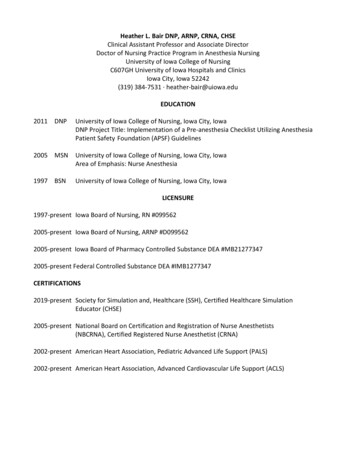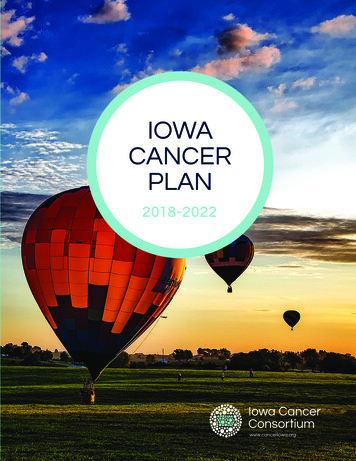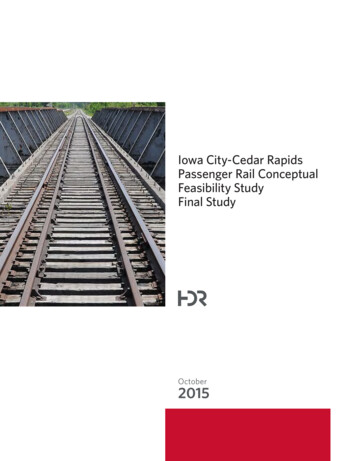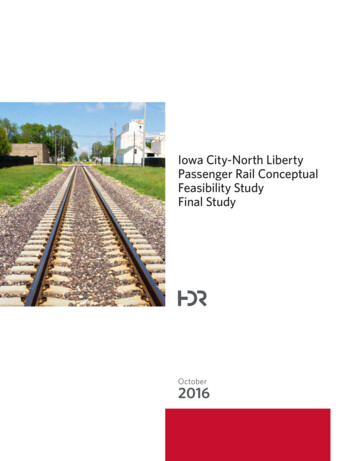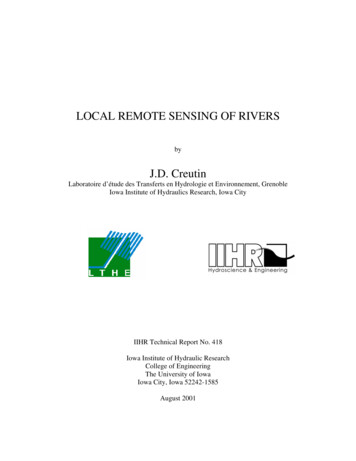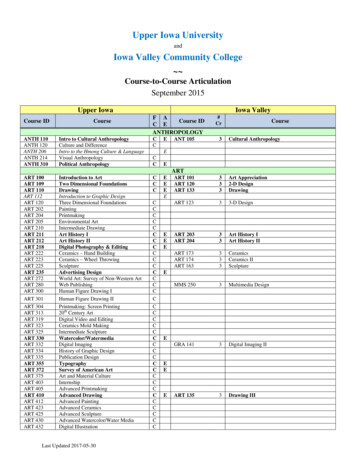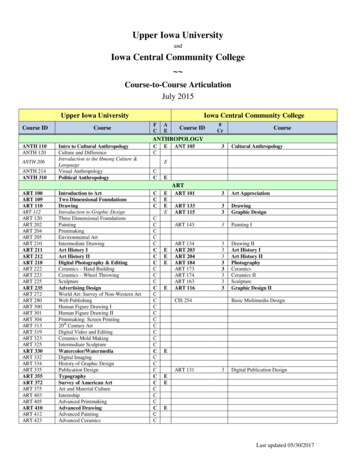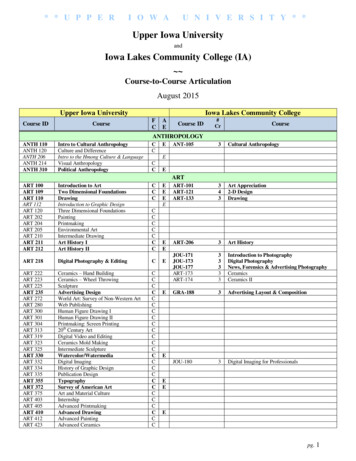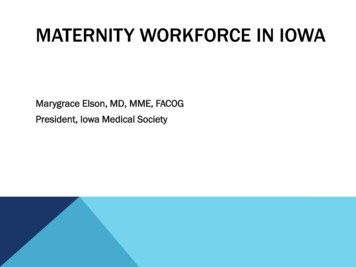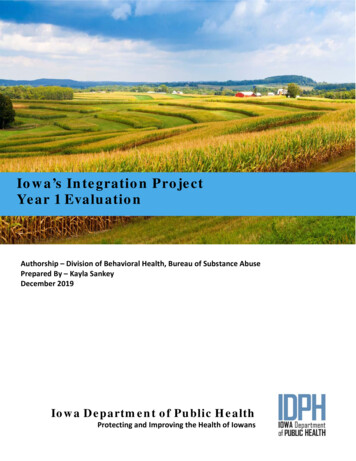
Transcription
Iowa’s Integration ProjectYear 1 EvaluationAuthorship – Division of Behavioral Health, Bureau of Substance AbusePrepared By – Kayla SankeyDecember 2019Iowa Department of Public HealthProtecting and Improving the Health of Iowans
Iowa’s Integration Project, Year 1 EvaluationAcknowledgementsSuggested Citation:Iowa Department of Public Health. Department of Behavioral Health, Bureau of Substance Abuse. Iowa’sIntegration Project, Year 1 Evaluation. Des Moines: Iowa Dept. of Public Health, December 2019.Gov. Kim ReynoldsLt. Gov. Adam GreggIDPH Interim Director Kelly GarciaReport Contact Information:Kayla Sankey, Project EvaluatorDivision of Behavioral Health, Bureau of Substance AbuseLucas State Office Building321 East 12th StreetDes Moines, Iowa r Robertson-Hill, Project DirectorDivision of Behavioral Health, Bureau of Substance AbuseLucas State Office Building321 E 12th StreetDes Moines, Iowa 1053Iowa’s Integration Project is funded by the Integration of Primary and Behavioral Health Care (PIPBHC –Grant No. 3H79SM080241). Iowa’s Integration Project is a five-year project awarded to the IowaDepartment of Public Health Division of Behavioral Health (IDPH) by the Substance Abuse and MentalHealth Services Administration – Center for Mental Health Services (SAMHSA-CMHS).Legal DisclaimerThis project was supported by the Iowa Department of Public Health, Des Moines, IA. The contents aresolely the responsibility of the authors and do not necessarily represent the official views of theSubstance Abuse and Mental Health Services Administration, Center for Mental Health Services, IowaDepartment of Public Health, Division of Behavioral Health or the University of Iowa.Iowa Department of Public Health, Division of Behavioral Health, Bureau of Substance Abuseii
Iowa’s Integration Project, Year 1 EvaluationTable of ContentsList of Tables and Figures . vExecutive Summary . 1Background . 1Methods . 1Key Findings . 1Recommendations . 2List of Acronyms. 3Introduction . 4Program Goals and Objectives . 4Methods . 5Site Descriptions . 5Client Eligibility . 6Data Collection . 6Client Recruitment . 8Admissions . 8Intake Coverage . 8Baseline Client Characteristics . 9Baseline Behavioral Health . 11Baseline Physical Health . 11Baseline Functional Outcomes. 12Screening, Brief Intervention and Referral to Treatment (SBIRT) . 13Interview Guide. 15FQHC Interview Guides . 15SUD Interview Guides . 16Client Retention. 18Recovery Support Services . 18Client Outcomes . 19Conclusion . 20Recommendations . 22Appendix A – Iowa’s Integration Project . 24Appendix B – Goals and Objectives . 25Iowa Department of Public Health, Division of Behavioral Health, Bureau of Substance Abuseiii
Iowa’s Integration Project, Year 1 EvaluationAppendix C – ICD-10-CM Codes . 27Appendix D – Recovery Support Services Descriptions . 30Appendix E – FQHC Behavioral Health Snapshot . 1Iowa Department of Public Health, Division of Behavioral Health, Bureau of Substance Abuseiv
Iowa’s Integration Project, Year 1 EvaluationList of Tables and FiguresList of FiguresFigure 1 Map of Iowa's Integration Project Organizations . 6Figure 2 Total Admissions for FY19 . 8Figure 3 Admissions by Partnership . 9Figure 4 Baseline Behavioral Health Diagnoses . 11Figure 5 Physical Health Indictor Data at Baseline . 12Figure 6 Functional Outcomes . 13Figure 7 Functional Outcomes Continued . 13List of TablesTable 1 Client Demographics . 9Table 2 SBIRT Tracking . 14Table 3 FQHC Staffing . 15Table 4 SUD Treatment Organizations Staffing . 17Iowa Department of Public Health, Division of Behavioral Health, Bureau of Substance Abusev
Iowa’s Integration Project, Year 1 EvaluationExecutive SummaryBackgroundIowa’s Integration Project is funded by the Promoting Integration of Primary and Behavioral Health Care(PIPBHC) grant. The Iowa Department of Public Health (IDPH) was awarded a five-year grant from theSubstance Abuse and Mental Health Services Administration (SAMHSA), Center for Mental HealthServices (CMHS) in September 2018. The purpose of the project is to improve primary and behavioralhealth outcomes for individuals with substance use disorders.Iowa’s Integration Project proposed to meet PIPBHC requirements through the following goals:1. Promote integrated health care services through a bidirectional model utilizing an IntegratedCare Team approach;2. Support the improvement of integrated health care services provided to individuals withsubstance use disorder (SUD), serious mental illness (SMI), and co-occurring health conditions;3. Increase the number of integrated health care services provided to individuals with SUD, SMI,and co-occurring health conditions;4. Implement an innovative and comprehensive care team approach between the Iowa ArmyNational Guard (IAANG) and co-located substance use/mental health community providers.MethodsData was gathered from several sources: 1) Intake Notification Forms; 2) Discharge Notification Forms;3) National Outcome Measures (NOMs) instrument at admission, discharge, and six-months postadmission (follow-up) from SAMHSA’s Performance Accountability and Reporting System (SPARS); 4)SUD Interview Guide; 5) Federally Qualified Health Center (FQHC) Interview Guide; 6) Monthly formscompleted by treatment providers; 7) Client Success Stories.Key Findings Eighty (80) clients were admitted between March 20, 2019 and September 29, 2019.The majority of clients were males (64%), White (91%), non-Hispanic or Latino (89%), andbetween the ages of 25-44 (67%).Over half (60%) of clients reported smoking daily or almost daily.Fifty-five percent (55%) had prehypertension or hypertension.Eighty-three percent (83%) were overweight or obese.Nearly half (44%) of clients identified as being unemployed but looking for work.Sixty-five percent (65%) of clients had a secondary behavioral health diagnosis, and almost onethird (31%) had a tertiary diagnosis.Organizations spent over 25,000 on recovery support services, of which two-thirds were spenton NOMs coordination and clothing/hygiene.Most staff have a basic understanding of integration, but there is room for improvement.Iowa Department of Public Health, Division of Behavioral Health, Bureau of Substance Abuse1
Iowa’s Integration Project, Year 1 EvaluationRecommendationsDue to the limited number of follow-ups and discharges completed in Year 1, recommendations arebased on baseline data, monthly tracking forms, and the SUD interview guide. As the PIPBHC grantcontinues to collect more data, future evaluations will be able to use follow-up and discharge data toinform recommendations. Explore ways to increase access to a more diverse client population to address and reducehealth disparities. The majority of clients are males (64%), White (91%), non-Hispanic or Latino(89%), and between the ages of 25-44 (67%).Offer education on people experiencing homelessness and how they may benefit fromservices. Almost every organization identified people experiencing homelessness as a specialpopulation with unmet primary health needs.Enhance efforts to address tobacco use and obesity. Over half (60%) of clients reportedsmoking daily or almost daily, had prehypertension or hypertension (55%), and were overweightor obese (83%). Throughout the first year of the grant, no organizations reported tobaccocessation programs, and minimal activities related to health/wellness were reported.Connect clients with resources on job training or employment opportunities. Nearly half (44%)of clients identified as being unemployed but looking for work.Connect clients with a primary care provider. Out of the total number of unique individualsseen at the SUD treatment organizations, nearly one-third do not have a primary care provider.Diversify recovery support services spending. Organizations spent over 25,000 on recoverysupport services, of which two-thirds were spent on NOMs coordination and clothing/hygiene.Additional funds can be used for services such as gas cards, wellness, or education.Explore ways to improve SBIRT implementation and tracking, such as increasing SBIRT trainingand communications between organizations and staff.Offer educational opportunities to organization staff to further their understanding ofintegrated care. The SUD interview guide revealed that staff’s understanding of integrationvaries, and there is room for additional education.Iowa Department of Public Health, Division of Behavioral Health, Bureau of Substance Abuse2
Iowa’s Integration Project, Year 1 EvaluationList of AcronymsCADS . . . .Center for Alcohol and Drug Services, Inc.CHC Community Health Care, Inc.CMHS Center for Mental Health ServicesFQHC . Federally Qualified Health CenterHOM . .House of MercyIAANG Iowa Army National GuardICD-10-CM International Statistical Classification of Diseases, 10th revision, Clinical ModificationIDPH . Iowa Department of Public HealthJRC . Jackson Recovery CentersNOMs National Outcome MeasuresPHC . Primary Health Care, Inc.Prelude .Prelude Behavioral ServicesRSS . .Recovery Support ServicesSAMHSA .Substance Abuse and Mental Health Services AdministrationSBIRT .Screening, Brief Intervention and Referral to TreatmentSCHC . .Siouxland Community Health CenterSMI .Serious Mental IllnessSPARS .SAMHSA’s Performance Accountability and Reporting SystemSUD . .Substance Use DisorderUCS .UCS HealthcareIowa Department of Public Health, Division of Behavioral Health, Bureau of Substance Abuse3
Iowa’s Integration Project, Year 1 EvaluationIntroductionThe Substance Abuse and Mental Health Services Administration (SAMHSA) awarded the IowaDepartment of Public Health (IDPH) a five-year grant for Promoting Integration of Primary andBehavioral Health Care (PIPBHC) in September 2018. The purpose of PIPBHC is to promote fullintegration and collaboration in clinical practice between primary and behavioral healthcare to serveindividuals with substance use disorders.As explained in the application submitted by IDPH for the initial funding opportunity, awards to primaryand behavioral healthcare programs would be made to the organizations that participated in theScreening, Brief Intervention and Referral to Treatment (SBIRT) program, funded by SAMHSA from 20122017. The organizations participating are three substance use disorder (SUD) treatment providers:Center for Alcohol and Drug Services, Inc. (CADS), Prelude Behavioral Services (Prelude), and JacksonRecovery Centers (JRC). All three SUD treatment organizations partner with the Federally QualifiedHealth Center (FQHC) in their respective regions to further integrate primary and behavioral healthcarepractices and building upon the foundation of SBIRT implementation. The FQHC’s involved in the PIPBHCgrant with the SUD treatment organizations are Community Health Care, Inc. (CHC), Primary HealthCare, Inc. (PHC), and Siouxland Community Health Center (SCHC). Iowa’s Integration Project alsoincludes a special project focusing on a community of high need, the Iowa Army National Guard(IAANG). This statewide project co-locates SUD treatment providers from two SUD treatmentorganizations (House of Mercy (HOM) and UCS Healthcare (UCS)) at the IAANG to further integration ofprimary and behavioral healthcare for Iowa’s soldiers. Appendix A displays the partnerships describedwithin this section.The objectives of this evaluation report were to: Assess the degree to which the project goals and objectives proposed in the grant applicationwere met for year one (September 30, 2018 to September 29, 2019).Provide an evaluation of data for clients admitted, beginning March 20, 2019.Explore the level of integrated care at each SUD treatment organization and FQHC.Program Goals and ObjectivesThe purpose of the PIPBHC grants outlined in the initial funding opportunity are to: 1) promote fullintegration and collaboration in clinical practice between primary and behavioral healthcare; 2) supportthe improvement of integrated care models for primary care and behavioral health care to improve theoverall wellness and physical health status of adults with a serious mental illness (SMI) or children with aserious emotional disturbance (SED); and (3) promote and offer integrated care services related toscreening, diagnosis, prevention, and treatment of mental and substance use disorders, and cooccurring physical health conditions and chronic diseases.Iowa’s Integration Project proposed to meet PIPBHC grant requirements through the following goals:Goal 1: Promote integrated health care services through a bidirectional model utilizing an IntegratedCare Team approach.Goal 2: Support the improvement of integrated health care services provided to individuals withSUD, SMI, and co-occurring health conditions.Iowa Department of Public Health, Division of Behavioral Health, Bureau of Substance Abuse4
Iowa’s Integration Project, Year 1 EvaluationGoal 3: Increase the number of integrated health care services provided to individuals with SUD,SMI, and co-occurring health conditions.Goal 4: Implement an innovative and comprehensive care team approach between the Iowa ArmyNational Guard (IAANG) and co-located substance use/mental health community providers.Appendix B lists corresponding objectives for each goal.MethodsThis report presents results for Iowa’s Integration Project from September 30, 2018 to September 29,2019. The IDPH established contracts in March 2019 and during this time, all of the organizationsinvolved had significant changes within their programs, including infrastructure, administration, andstaffing. These changes created a significant delay in implementation of the project, with clientadmissions ultimately beginning on March 20, 2019.Site DescriptionsFigure 1 displays the geographic location of the organizations providing services for Iowa’s IntegrationProject across the state. JRC and SCHC are located on Iowa’s western border in Sioux City, Iowa. SiouxCity is the fourth largest city in Iowa with a population of 82,396 1. Prelude, PHC, and the IAANG arecentrally located near Des Moines, Iowa. Des Moines, the capital and largest city in Iowa, has apopulation of 216,853 residents 2. CADS and CHC are located on Iowa’s eastern border, in Davenport,Iowa. Davenport is the third largest city in Iowa with a population of 102,085 residents 3.U.S. Census Bureau. (2018). QuickFacts: Sioux City, Iowa. Retrieved from http://quickfacts.census.gov.U.S. Census Bureau. (2018). QuickFacts: Des Moines, Iowa. Retrieved from http://quickfacts.census.gov.3U.S. Census Bureau. (2018). QuickFacts: Davenport, Iowa. Retrieved from http://quickfacts.census.gov.12Iowa Department of Public Health, Division of Behavioral Health, Bureau of Substance Abuse5
Iowa’s Integration Project, Year 1 EvaluationFigure 1 Map of Iowa's Integration Project OrganizationsClient EligibilityEligibility for admission into Iowa’s Integration Project included that an individual must meet thefollowing criteria:1. Eighteen (18) years or older2. Resident of the state of Iowa3. Received a diagnosis for a substance use disorder and meet one of the two following criteria:a. Has or is at risk of a chronic physical health condition and/orb. Has received a diagnosis of a serious mental illness (serious mental illness is defined bysomeone over 18 having (within the past year) a diagnosable mental, behavioral, oremotional disorder that causes serious functional impairment that substantiallyinterferes with or limits one or more major life activities).4. Client is at or below 200% of the current Federal Poverty Guidelines.Data CollectionData was gathered from March 20, 2019 through September 29, 2019 from a variety of sourcesincluding:Iowa Department of Public Health, Division of Behavioral Health, Bureau of Substance Abuse6
Iowa’s Integration Project, Year 1 Evaluation1. Intake and Discharge Notification Forms. The intake and discharge notification forms weredeveloped by IDPH to collect client-level data on functional outcomes. These forms wereadministered by project staff during the NOMs baseline or discharge interview. Functionaloutcomes included participation in supportive housing or independent living programs, criminaljustice involvement, attendance in social & rehabilitative programs, participation in job trainingopportunities, satisfactory performance in work settings, attendance at scheduled medical andbehavioral health appointments, and compliance with prescribed medication regimes.2. National Outcome Measures (NOMs) instrument at baseline, reassessment, and dischargefrom SAMHSA’s Performance Accountability and Reporting System (SPARS). SAMHSA’s NOMstool is a standardized questionnaire that gathers client-level data at baseline, quarterlyreassessment, six-month reassessment, and discharge interviews. In total, 80 baseline, thirteenquarterly reassessments, one six-month reassessment, and three discharges were collected. Dueto the low number of reassessments and discharges, only baseline NOMs data is included in thisevaluation. PIPBHC grantees were also required to complete a program-specific section ofNOMs, which tracks physical health indicator (PHI) data. PHI data reported includes height,weight, blood pressure, plasma glucose/HgbA1c, and cholesterol. These data were used asbiomarkers for obesity, hypertension, diabetes, and hypercholesterolemia.3. FQHC and SUD Interview Guides. The Iowa Primary Care Association (IPCA) developed andadministered interview guides to FQHC’s across the state of Iowa to determine their level ofintegrated care in March 2019. IDPH was able to adapt the FQHC interview guide for SUDorganizations to gather similar data in October 2019. Together, both the FQHC and SUDinterview guides provided IDPH with baseline data on the level of integrated care for Iowa’sIntegration Project organizations.4. Monthly forms completed by treatment providers. IDPH developed monthly tracking forms tocollect data on staff training, recovery support services (RSS), SBIRT implementation, andIntegrated Care Team activities, which included mental health prevention and promotion.5. Client Success Stories. Iowa’s Integration Project organizations submitted client success storiesto IDPH and are included throughout this report.Iowa Department of Public Health, Division of Behavioral Health, Bureau of Substance Abuse7
Iowa’s Integration Project, Year 1 EvaluationClient RecruitmentThis section provides an overview on the clients admitted into Iowa’s Integration Project.AdmissionsBetween March 20, 2019 and September 29, 2019, Iowa’s Integration Project served 80 clients acrossthe state. Targeted, actual, and monthly admissions counts are discussed below.Intake CoverageIowa’s Integration Project proposed to provide services to 175 unduplicated individuals annually, witheach of the three main project sites partnered with an FQHC serving 50 clients annually, and the IAANGserving 25 clients annually. Staff capacity led to a delay in client admissions, and therefore, Iowa’sIntegration Project only admitted 46% of the targeted number of clients. Figure 2 shows the number ofclients admitted into Iowa’s Integration Project compared to the target number of clients.Figure 2 Total Admissions for FY19Total Admissions for FY19Number of Clients Admitted20017515010080500TargetFY19EnrolledFigure 3 illustrates admissions by each partnership. Starting in May, admissions increased each month,reaching a high of 25 clients in September. IAANG was the first organization to admit a client; however,they were only able to admit one client during the first year due to significant deployments and limiteddrill weekends. JRC and SCHC started admitting clients in July, and admitted a total of 7 clients withinthe first year. Prelude and PHC started admitting clients in May, and admitted 22 clients within the firstyear. CADS and CHC started admitting clients in June, and were the only partnership to achieve the goalof 50 client admissions for FY19.Iowa Department of Public Health, Division of Behavioral Health, Bureau of Substance Abuse8
Iowa’s Integration Project, Year 1 EvaluationFigure 3 Admissions by PartnershipAdmissions by PartnershipsNumber of Clients eJulyAugustSeptemberFY 2019JRC/SCHCADS/CHCPrelude/PHCIAANGBaseline Client CharacteristicsTable 1 displays baseline characteristics of the 80 clients admitted in Iowa’s Integration Project betweenMarch 20, 2019 and September, 29 2019. The median age of all clients is 38 years. The age group 35-44years had the highest number of clients (37%) with 25-34 years being the second highest (30%). Overall,most clients were male (64%), White/Caucasian (91%) and non-Hispanic or Latino (89%). Forty-onepercent (41%) of clients reported graduating 12th grade/receiving a high school diploma, followedclosely by completing some college or university (31%). Nearly half (44%) identified as beingunemployed but looking for work, followed by being employed full-time (21%).Table 1 Client DemographicsClient CharacteristicsAge (median)n (%)3818-25* (*)25-3424 (30)35-4430 (37)45-5415 (19)55-647 (9)65 * (*)GenderMale51 (64)Iowa Department of Public Health, Division of Behavioral Health, Bureau of Substance Abuse9
Iowa’s Integration Project, Year 1 EvaluationFemale29 (36)RaceWhite/Caucasian73 (91)Black/African American* (*)Asian* (*)Native Hawaiian/other Pacific Islander* (*)Alaska Native0 (0)American Indian* (*)Other* (*)EthnicityHispanic or Latino9 (11)Non-Hispanic or Latino71 (89)EducationLess than 12th Grade9 (11)12 Grade/High school diploma/GED33 (41)thVOC/Tech diploma6 (8)Some college or university25 (31)Bachelor’s degree (BA,BS)7 (9)EmploymentFull-time17 (21)Part-time10 (12)Unemployed, looking for work35 (44)Unemployed, disabledUnemployed, not looking for workOther* (*)10 (13)* (*)*Totals of 1-5 are suppressedIowa Department of Public Health, Division of Behavioral Health, Bureau of Substance Abuse10
Iowa’s Integration Project, Year 1 EvaluationSuccess Story: What was the turning point at which you chose to begin your path to recovery: “January 2018 Itotaled my car after being up for 7 days on meth. The following day I went to Riverside on my own andchecked myself in.” What do you want to share with others about your recovery: “It has not been easy and don’t expect it tobe. Learn to ask for help.” Describe what healthy changes you made regarding your use of alcohol or drugs? “I don’t use and I stayconnected to all of my support and keep myself involved with lots of recovery based classes and groups.” How is your life better today as a result of reducing or eliminating your use of drugs or alcohol? “I amfinancially balanced. My relationship with my family is great. I have a career working with those whostruggle with addiction. Life is much better.”- Male receiving services through SUD provider, part of the Integrated Care TeamBaseline Behavioral HealthFigure 4 displays clients’ primary, secondary, and tertiary behavioral health diagnoses reported usingICD-10-CM codes by program staff. Diagnoses are collected in SPARS during the NOMs baselineinterview. A list of the ICD-10-CM codes collected in SPARS is included in Appendix C. The most commonbehavioral health diagnosis was alcohol use disorder (25%), followed closely by other stimulant disorder(23%). The third most common behavioral health diagnosis was major depressive disorder (13%),followed closely by anxiety-related disorders (12%), and opioid use disorder (10%).Figure 4 Baseline Behavioral Health DiagnosesBaseline Behavioral Health DiagnosesAlcohol Use Disorder26%DiagnosesOther Stimulant Disorder23%Major Depressive Disorder13%Anxiety Related Disorders12%Opioid Use Disorder10%Cannabis Use Disor
Division of Behavioral Health, Bureau of Substance Abuse . Lucas State Office Building . 321 East 12. th Street . Des Moines, Iowa 50319 . Kayla.sankey@idph.iowa.gov 515-204-9154 . Jennifer Robertson-Hill, Project Director . Division of Behavioral Health, Bureau of Substance Abuse . Lucas State Office Building . 321 E 12th Street . Des Moines .


